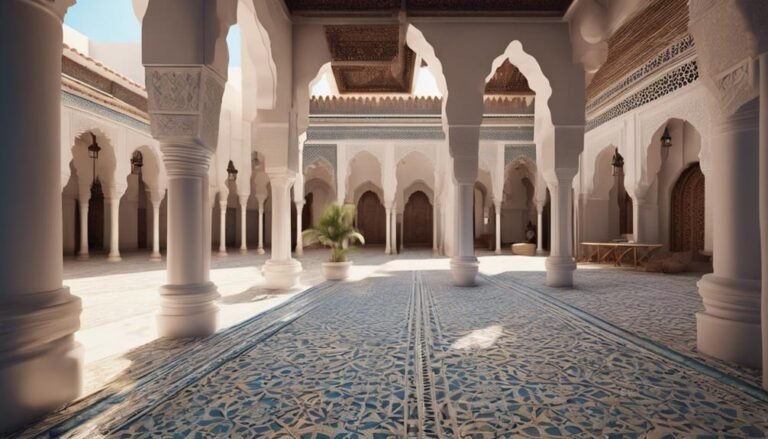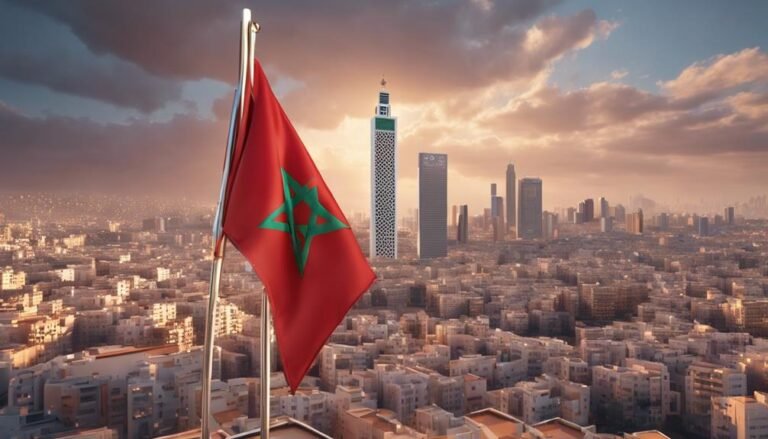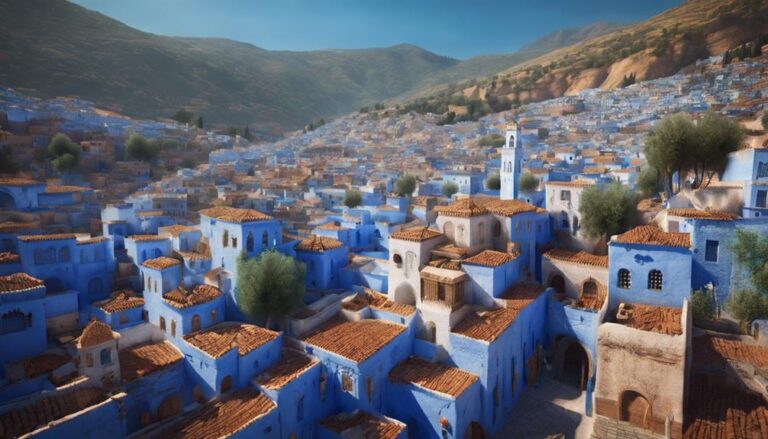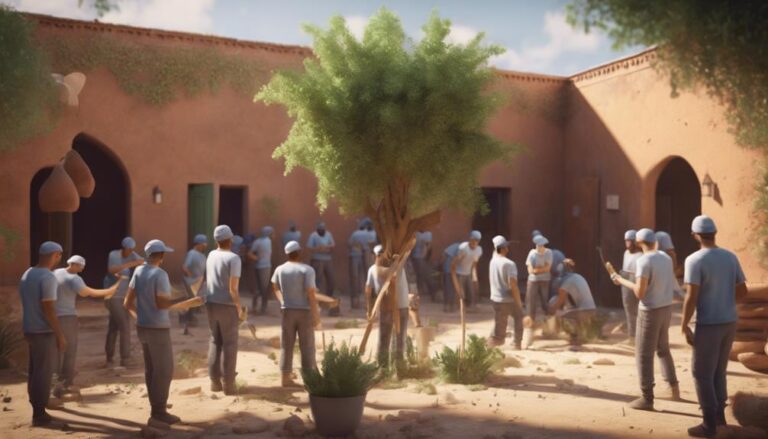In Morocco, internet connectivity is evolving positively. The penetration rate is rising, meaning more people are getting online. Broadband availability has expanded, offering faster connections. Affordable pricing plans make internet access more feasible. Various age groups are embracing online activities, boosting usage from social media to e-commerce. Younger individuals show particularly active engagement. Investments in infrastructure are essential for this growth, alongside technological advancements driving progress. Mobile internet is on the rise too, with smartphone ownership increasing. If you want to discover more about Morocco's dynamic internet landscape, there's a lot to explore further.
Key Takeaways
- Increasing internet penetration rate in Morocco.
- Broadband availability and affordability are improving.
- Rise in mobile internet usage due to smartphone ownership.
- Efforts to bridge the urban-rural digital connectivity gap.
- Government and private sector collaborations enhancing internet infrastructure.
Internet Penetration Rate in Morocco
When examining the internet penetration rate in Morocco, it becomes evident that the country has made important strides in expanding online access in recent years. Broadband availability has increased notably, with more affordable pricing plans becoming accessible to a wider demographic. This shift has played a vital role in enhancing internet usage habits across various age groups and socio-economic backgrounds.
In terms of internet usage habits, Morocco has seen a rise in online activities ranging from social media engagement to e-commerce transactions. Demographically, the younger population tends to be more active online, utilizing the internet for education, entertainment, and communication purposes. However, there's a growing trend of older generations also embracing the digital world for information and connectivity.
Infrastructure Development and Investment
Infrastructure development and investment play a pivotal role in shaping the internet connectivity landscape in Morocco, driving advancements in accessibility and reliability. The expansion and enhancement of infrastructure require substantial funding sources to support the deployment of modern technologies. In Morocco, both public and private funding sources contribute to the development of internet infrastructure, aiming to bridge the digital divide and improve connectivity nationwide.
The table below provides a brief overview of the key elements related to infrastructure development and investment in Morocco:
| Aspect | Description |
|---|---|
| Funding Sources | Public and private investments are essential for expanding and upgrading internet infrastructure. |
| Technology Advancements | Technological advancements drive the evolution of internet infrastructure, enhancing performance. |
| Accessibility | Improved infrastructure leads to better internet accessibility, benefiting users across the country. |
Mobile Internet Usage Trends
Mobile internet usage trends in Morocco reflect a significant shift towards increased reliance on smartphones for online activities. This shift is influenced by several factors:
- Smartphone Penetration: The rise in smartphone ownership has led to more Moroccans using their mobile devices to access the internet. This increased penetration has made mobile internet more accessible to a larger portion of the population.
- Data Consumption Habits: With the availability of affordable mobile data plans, Moroccans are consuming more data on their smartphones. Streaming videos, social media usage, and online gaming are becoming more prevalent activities on mobile networks.
- Mobile Network Coverage: Improvements in mobile network coverage across Morocco have also contributed to the growth in mobile internet usage. Better coverage in rural areas and faster data speeds in urban centers have made accessing the internet on the go more convenient for users.
Internet Speed and Connectivity Issues
Enhancements in internet speed and connectivity are essential for ensuring seamless online experiences for users in Morocco. Broadband availability plays a vital role in this regard, as it provides faster and more reliable internet connections compared to traditional dial-up options. In recent years, Morocco has seen significant improvements in broadband availability, with more households and businesses gaining access to high-speed internet services.
Affordability is another key factor influencing internet speed and connectivity in Morocco. While technological advancements have led to faster internet speeds, ensuring that these services are affordable for the general population remains a challenge. Innovations in internet infrastructure, such as the deployment of fiber-optic networks, have the potential to further enhance internet speed and connectivity across the country.
Despite these advancements, disparities in internet speed and connectivity still exist in certain regions of Morocco. Addressing these disparities and ensuring equal access to high-speed internet services for all citizens will be essential in bridging the digital divide and fostering a more connected and inclusive society.
Digital Divide: Urban Vs. Rural Areas
As Morocco progresses in improving internet speed and connectivity, a notable contrast emerges between urban and rural areas regarding digital access and resources.
- Connectivity Disparities: Urban areas generally enjoy faster and more reliable internet connections compared to rural regions. This gap in connectivity can hinder rural residents from accessing online resources and participating fully in the digital world.
- Bridging the Gap: Efforts are being made to bridge this disparity by implementing initiatives that aim to extend broadband infrastructure to rural areas. By investing in expanding internet coverage, Morocco can work towards creating a more inclusive digital landscape where all citizens have equal opportunities for online engagement.
- Rural Internet Access, Challenges, and Solutions: Challenges such as limited infrastructure, high costs, and low population density in rural areas make it difficult to provide reliable internet access. Solutions like implementing community networks, satellite internet, and mobile data services can help overcome these obstacles and improve digital access in rural Morocco.
Future Prospects and Initiatives
As you explore the future prospects and initiatives shaping internet connectivity in Morocco, you'll encounter a landscape marked by infrastructure development plans aimed at bridging the digital divide.
Government initiatives play a pivotal role in the expansion of internet access, while partnerships with the private sector are poised to drive innovation and enhance connectivity across the country.
These key points underscore a concerted effort to bolster Morocco's digital infrastructure and guarantee widespread access to the internet.
Infrastructure Development Plans
In preparing for the future of internet connectivity in Morocco, significant efforts are underway to develop and expand the infrastructure to meet the growing demands of the digital age. The country is focusing on enhancing its infrastructure to guarantee better internet accessibility for all citizens.
Key initiatives and plans include:
- Digital inclusion initiatives: Implementing programs to guarantee that all segments of society have access to the internet, promoting digital literacy and skills development.
- Broadband expansion plans: Rolling out projects to extend high-speed internet access to more regions, improving connectivity nationwide.
- Infrastructure upgrades: Investing in the enhancement of existing network infrastructure to support faster and more reliable internet services for users across the country.
Government Initiatives for Expansion
The Moroccan government is spearheading various initiatives aimed at expanding internet connectivity to bolster the nation's digital infrastructure for future growth and development. Through substantial government funding, initiatives are being undertaken to improve rural connectivity, ensuring that even remote areas have access to the internet.
By investing in infrastructure development, the government aims to bridge the digital divide between urban and rural regions, providing equal opportunities for all citizens to benefit from online resources and services. These initiatives not only aim to enhance internet accessibility but also to stimulate economic growth, promote innovation, and empower communities across the country.
With a focus on expanding connectivity to underserved areas, the government is working towards creating a more inclusive and digitally connected society in Morocco.
Private Sector Partnerships
Private sector partnerships in Morocco's internet connectivity landscape are poised to play a pivotal role in shaping future prospects and driving innovative initiatives. Public-private collaborations offer a unique opportunity for leveraging resources and expertise to enhance connectivity nationwide. Technology advancements present a fertile ground for private sector players to introduce cutting-edge solutions and infrastructure developments, ultimately improving the overall quality and accessibility of internet services in Morocco.
- Public-private collaborations can foster innovation and cost-sharing.
- Leveraging private sector expertise can lead to more efficient deployment of connectivity solutions.
- Technology advancements enable the introduction of state-of-the-art infrastructure and services, benefiting the internet landscape in Morocco.
Conclusion
You've learned about the internet connectivity in Morocco, from the increasing penetration rate to the challenges of speed and connectivity.
Despite these issues, there's hope for the future with ongoing infrastructure development and investment.
The digital divide between urban and rural areas remains a concern, but initiatives are being implemented to bridge this gap.
Stay informed and hopeful for a more connected Morocco in the years to come.

The Editorial Team is a passionate group of Morocco enthusiasts dedicated to sharing the beauty, culture, and wonders of this captivating country. With diverse backgrounds and a deep love for travel, we strive to bring you engaging and informative content that inspires your Moroccan adventures. From uncovering hidden gems and sharing local insights to exploring mouthwatering cuisine and showcasing the vibrant lifestyle, our team is committed to providing you with valuable resources and exciting stories that enhance your exploration of Morocco. Join us on this journey as we celebrate the rich heritage and unforgettable experiences that make Morocco truly special.







